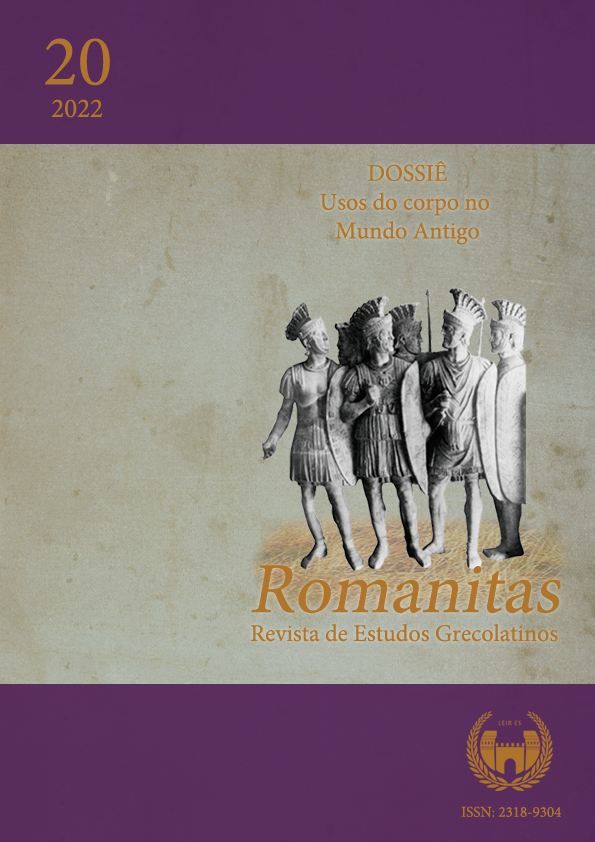Beyond Pandora: the human and civic female body (5th – 4th centuries BC)
DOI:
https://doi.org/10.29327/2345891.20.20-3Keywords:
Gender relations, Female body, Aristophanes, HippocratesAbstract
From Classical Antiquity to our days, cultural markers of gender crossed and still cross the understanding of the body. They give meaning to the identities deemed feminine and masculine in a historical context. In Classical Greek societies, such markers draw on, to a greater or lesser extent, “the race of women”, a category set apart from humanity since it was founded on the mythical figure of Pandora. However, the textual testimonies of the period, notably Aristophanic comedy and Hippocratic medicine, reveal to us that such mythical canon did not limit the possibilities of representation and the uses of female bodies, especially concerning married women. Thus, this article aims to show that both Aristophanes and Hippocrates express a masculine thought capable of including the feminine as an active participant in the construction of the human body and the Athenian civic body.
Downloads
References
Documentação textual
ARISTÓFANES. Duas Comédias: Lísistrata e As tesmoforiantes. Tradução, apresentação e notas de Adriane da Silva Duarte. São Paulo: Martins Fontes, 2005.
ARISTÓFANES. Lisístrata. Tradução de Ana Maria César Pompeu. Introdução de Isabella Tardin Cardoso. São Paulo: Hedra, 2010.
HIPPOCRATES. The Hippocratic Treatises On Generation, On the Nature of the Child, Diseases IV: a commentary. Edited and translated by Ian Malcom Lonie. Berlin: De Gruyter, 1981.
HIPÓCRATES. Tratados Hipocráticos IV. Introducciones, traducciones y notas por Carlos García Gual. Madrid: Gredos, 1998.
HIPPOCRATES. Volume X. Edited and translated by Paul Potter. Cambridge: Harvard University Press, 2012.
Obras de apoio
ANDRADE, M. M. A Cidade das mulheres: cidadania e alteridade feminina na Atenas Clássica. Rio de Janeiro: LHIA, 2001.
ANDRADE, M. M.; SILVA, A. C. L. F. da. Mito e gênero: Pandora e Eva em perspectiva comparada. Cadernos Pagu, n. 33, p. 313-324, 2009.
BORGES, V. R. História e Literatura: algumas considerações. Revista de Teoria da História, Ano 1, n. 3, p. 94-109, 2010
BLOK, J.H. Perikles' citizenship law: a new perspective. Historia: Zeitschrift für Alte Geschichte Bd. 58, H. 2, p. 141-170, 2009.
CAIRUS, H..; RIBEIRO, W. Textos hipocráticos: o doente, o médico e a doença. Rio de Janeiro: Fiocruz, 2005.
CHANOCA, T. O lugar do mito de Pandora nos poemas de Hesíodo: Teogonia 570-612 e Os trabalhos e os dias 54-104. Ágora. Estudos Clássicos em Debate, n. 21, p. 21-42, 2019.
CRAIK, E. M. The ‘Hippocratic’ Corpus: content and context. London: Routledge, 2015.
CRAIK, E. M. The ‘Hippocratic Question’ and the nature of the Hippocratic Corpus. In: PORMANN, P. E. (ed.). The Cambridge companion to Hippocrates. Cambridge: Cambridge University Press, 2018, p. 25-37.
DEAN-JONES, L. A. Women’s bodies in Classical Greek science. Oxford: Clarendon Press, 1994.
DEMAND, N. Birth, death, and motherhood in Classical Greece. Baltimore: The John Hopkins University Press, 1994.
DRUMMOND, G. A queda do herói cômico: o papel do protagonista em Nuvens, Vespas e Tesmoforiantes. Revista do Laboratório de Dramaturgia, v. 13, n. 5, p. 60-86, 2020.
ENTRALGO, P. L. La medicina hipocrática. Madrid: Alianza, 1970.
FUNARI, P. P. A. Guerra do Peloponeso. In: MAGNOLI, D. (org.). História das guerras. São Paulo: Contexto, 2006, p. 19-46.
HARRIS, O. J. T.; ROBB, J. (ed.). The body in History: Europe from the Palaeolithic to the Future. Cambridge: Cambridge University Press, 2013.
JOUANNA, J. Hippocrate. Paris: Fayard, 1992.
KING, H. Hippocrates’ woman: reading the female body in Ancient Greece. London: Routledge, 1998.
KING, H. Midwifery, obstetrics and the rise of gynaecology: the uses of a sixteenth-century compendium. Aldershot: Ashgate, 2007.
LESSA, F. S. O feminino em Atenas. Rio de Janeiro: Mauad, 2004.
LORAUX, N. The children of Athena: Athenian ideas about citizenship and the division between the sexes. Princeton: Princeton University Press, 1994.
MALHADAS, D.; DEZOTTI, M. C. C.; NEVES, M. H. de. Dicionário grego-português. São Paulo: Ateliê, 2006-2010. v.1-5.
NUTTON, V. Humoralism. In: BYNUM, W.F. PORTER, R. (ed.). Companion Encyclopedia of the History of Medicine. London: Routledge, 1993, p. 281-291.
REBOLLO, R. A. Considerações sobre o estabelecimento da Medicina no tratado hipocrático Sobre a arte médica. Scientiae Studia, v. 1, n. 3, p. 275-297, 2003.
REBOLLO, R. A. O legado hipocrático e sua fortuna no período greco-romano: de Cós a Galeno. Scientiae Studia, v. 4, n. 1, 2006.
SCHIEFSKY, M. Hippocrates on ancient Medicine. Boston: Brill, 2005.
ZEITLIN, F. Signifying difference: the myth of Pandora. In: HAWLEY, R.; LEVICK, B. (ed.). Women in Antiquity: New assessments. London: Routledge, 1995.
Downloads
Published
How to Cite
Issue
Section
License
Copyright (c) 2023 Bárbara Alexandre Aniceto

This work is licensed under a Creative Commons Attribution-NonCommercial-NoDerivatives 4.0 International License.
a. The authors retain copyright and grant the journal the right to first publication.
b. The authors are authorized to assume additional contracts separately, for non-exclusive distribution of the version of the work published in this journal (e.g., publishing in institutional repository or as a book chapter), with acknowledgment of authorship and initial publication in this journal.
c. Authors are allowed and encouraged to publish and distribute their work online (e.g. in institutional repositories or on their personal page) after the first publication by the journal, with due credit.
d. The journal's texts are licensed under a CC BY 4.0 Deed Attribution 4.0 International Licence (CC BY).




























